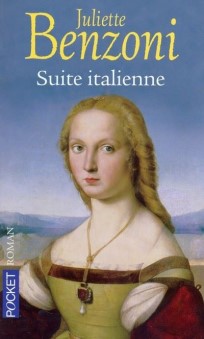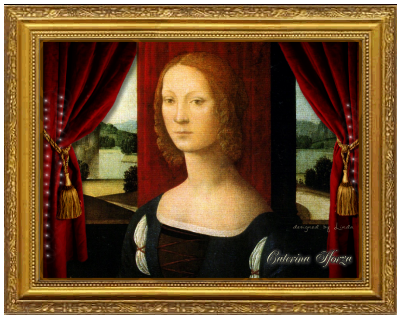

(re-issued : Suite Italienne
2005)
|
Foreword by
Juliette BENZONI |
|
Italy! Long before it
had one of its old names, it occupied my imagination. I
must have been fourteen or fifteen when the virus hit
me. That year, André Chamson, then curator of the
Petit Palais, had literally plundered the museums
of the Peninsula, in particular the Uffizi in
Florence, for a fabulous exhibition and, for months
on end, Italian Art - as it was called - had Paris,
France and part of Northern Europe in a frenzy. From
Cimabue to Tiepolo - the announced programme - the
finest works by Angelico, Uccello, Botticelli - I
was particularly fond of the Madonna with a Pomegranate
- Ghirlandaio, Verrocchio, Vinci, Raphael, Michelangelo,
Titian, Veronese and Piero della Francesca covered the
walls of the palace in their splendour. It was a
dazzling experience that I had to go and see a dozen
times with my mother, my school, friends, cousins from
the provinces and anyone else I could get my hands on to
have a chance to go back. It was magical!
As art history was
developed at an early age in the dear house responsible
for adorning my mind while imbuing me with the
ingredients necessary for a decent baccalaureate, I was
already familiar with the main painters, but in
isolation. Bringing them together was like fireworks,
and as usual, I turned to History to learn a little more
about the characters in this fascinating world, which
was also disturbing because of its shadows and contrasts.
Stendhal's chronicles for the music and a few solid
historians for the lyrics, Renaissance Italy is a
fantastic opera where blood and mud serve as fertiliser
for the blossoming of a superhuman beauty renewed from
ancient Greece and the refinements of a mosaic of
principalities led by characters from fantastic tales.
Because this Italy, which did not yet bear its own name,
was spelt Medici, Borgia - although they were
Spaniards, like the Aragons of Naples - Este, Sforza and
so on. They were all colourful patrons of the arts,
enamoured of a certain art de vivre, but cruel,
debauched, sometimes ferocious and without the slightest
regard for human life, like Cesare Borgia, revered by
Machiavelli, who made him "The Prince", but whose
mask of gold-embroidered velvet concealed the ravages of
syphilis...
Women are the height
of their excess, whether they are victims or rulers.
Their beauty has stood the test of time, on its way to
eternity, their excesses a little less so, but in
lifting the veil of the centuries, this « Italian Suite
» aims to restore them to their human reality by
revealing what the glittering brocades of their dresses
have concealed of pain, hatred or resignation.
|
|
Synopsis :
Dames Drames et Demons 1980 |
|
Ladies Dramas and
Demons

Renaissance Italy! A fabulous fresco of gold,
azure, purple and flowers, composed like a work
of art intended to achieve the greatest possible
sum of earthly happiness. But its splendours,
renewed from ancient Greece, and its almost
divine art, were born of unbridled violence,
princely lust and the bloody excesses of the
street, a thick and fertile mire magnifying the
beauty of women and the refinements of an
exceptional culture and a certain art of living.
In this often diabolical plot, Princes are
kidnapped in high relief, because Renaissance
Italy is also written Borgia, Medici. Este,
Sforza...
It's Florence, submissive as a woman in love to
the powerful yet charming ugliness of Lorenzo
the Magnificent. It's Rome, boiling like a
witch's cauldron under its playful, artistic and
bloodthirsty Popes, but trembling under the whip
of Cesare Borgia, whose black mask hides the
ravages of syphilis. It's Ferrara and its
rebellious duchesses. It is Milan and Beatrice
d'Este's last ball, whose supreme chord ends in
a requiem. It is, finally, above all, the
vivacious sprout of youth springing, sovereign,
from the old Italian soil to go and blossom all
over Europe.
A paperback volume of 266 pages, with original
colour cover. Éditions Trévise
Table of contents
BORGIA (ROME) MÉDICIS (FLORENCE) ESTE (FERRARE)
CAPELLO (VENICE) SFORZA (MILAN and FORLI) CARAFA
(NAPLES) VENOSA (NAPLES)
|
 |
Light, fickle, fleeting pleasure accompanied
by a thousand torments, through the deceptive
brilliance with which you dazzle us, you hide
cruel evils and your rich, brilliant finery
covers hideous monsters....

~ Lorenzo de' Medici ~ Portrait of
Lorenzo de' Medici. Oil on canvas by Agnolo Bronzino. 1555/1565. Galleria degli
Uffizi, Firenze photo:
Public domain |
|
|
|
|

À Claude
Versini
À l'Àmitié incarnée... ℐℬ / To
Claude Versini : To Friendship unlimited...ℐℬ |
|

Dames, drames & démons was republished by
Editions Bartillat in 2005 under the title :
Suite
Italienne.

|
Synopsis: Suite Italienne 2005 |
This Italian suite is made up of paintings
featuring the great figures of the Renaissance.
Each family is associated with a city of vast
influence. Rome, boiling like a witch's cauldron
under its playful, artistic and bloodthirsty
popes, but trembling under the whip of Caesar
Borgia, whose black mask hides the ravages of
syphilis. Florence, submissive as a woman in
love to the powerful yet charming ugliness of
Lorenzo de' Medici.
Ferrara and its rebellious duchesses, Venice and
its witch, Milan and Beatrice d'Este's last ball...
At the same time, the ancient land of Italy was
to offer the world a civilisation that would
serve as a model. With her immense talent,
Juliette Benzoni recounts the fantastic
chronicles of these sovereigns, whose beauty and
excesses were to become eternal...
~
Cover: DV Arts Graphics
-
Illustration : La Bella Palme The Old
~ [
Location : Museum
Thyssen-Bornemisza, Madrid, Spain
]
|
Synopsis: Suite Italienne 2015 |

re-issued by
Bartillat
in 2015
A rediscovery of Benzoni to start the year.
News about the great families of the Renaissance
in Italy: the Borgias, etc.
This Italian suite is made up of paintings
featuring the great figures of the Renaissance.
Each family is associated with a city of vast
influence. Rome, boiling like a witch's cauldron
under its playful, artistic and bloodthirsty
popes, but trembling under the whip of Cesare
Borgia, whose black mask hides the ravages of
syphilis. Florence, submissive as a woman in
love to the powerful yet charming ugliness of
Lorenzo de' Medici. Ferrara and its rebellious
duchesses, Venice and its witch, Milan and
Beatrice d'Este's last ball... At the same time,
the ancient land of Italy was to offer the world
a civilisation that would serve as a model. With
her immense talent, Juliette Benzoni recounts
the fantastic chronicles of these sovereigns,
whose beauty and excesses were to become eternal...
~
Cover : illustration : the lady with an ermine
1488 - 1490 by Leonardo da Vinci
~ [
Location :
Museum Czartoryski, Cracow, Poland]
|
Synopsis: Suite Italienne 2005 - 06 |

published by Pocket 2005 & re-issued
2006
For centuries, the Italian Renaissance has been
synonymous with cultural influence. A sublime
era devoted to the development of the arts and
sciences, these glorious years were also subject
to the antics of its all-powerful rulers.
In Rome of the pleasure-seeking popes, the
redoubtable Cesare Borgia gives free rein to his
murderous madness. In Florence, the charismatic
Lorenzo de' Medici establishes his domination
through refinement, seduction and hushed cruelty.
In the heart of modern Ferrara, the secrets of
sensual duchesses are whispered, while Venice,
Naples and Milan become the scene of
conspiracies and tragic passions.
A series of chronicles dedicated to lovers of
history and its sulphurous protagonists.
~
Cover : Illustration : Lady with a unicorn,
Portrait of a young woman with a unicorn by Rafaello Sanzio
of Urbino
(Raphaël)
~ [
Location :
Museum de la Galleria Borghese, Rome, Italy]
|
Synopsis:
THE BORGIA'S 2012 |

►This
edition is an extract from Suite Italienne from
which the Borgia story has been removed. We can
assume that Pocket was inspired by the various
television series about the Borgias...!
The Borgias. This Spanish family, which produced
two popes and ruled 15th-century Rome, is best
remembered for its sulphurous legend: poison,
fratricide, incest and stupor under the gold of
the Vatican.
The Holy See, the seat of power at the time, was
in the hands of the controversial Pope Alexander
VI, and was a hotbed of desire. Internal wars
and secret alliances, treachery and
Machiavellian plots, the black mask of Cesare
Borgia, covering his syphilis-ridden face,
haunts the corridors of history.
~
Cover: Illustration : Tintoretto, Portrait of
Lucrezia Borgia (detail) )
~ [
Location :
Museum of the Vatican, Rome, Italy]
♣ The Novel was also
translated in the Countries
:
|

Les Éditions : République Tchèque et Croatie |
|

Countess Caterina Sforza
of Imola & Forli
Countess Caterina Sforza, a
woman much admired by Juliette Benzoni ! It was
thanks to the Italian Renaissance that Juliette
Benzoni caught the eye of Gérald Gauthier (Press
Agent Opéra Mundi) and of the esteemed historian
Alain Decaux during the TV transmision 'Gros Lot
in 1959'.

[ creation © Linda Compagnoni Walther]
|

© 2008
- 2025 juliette-benzoni-tribute
tous
droit
réservé
non profit site
|